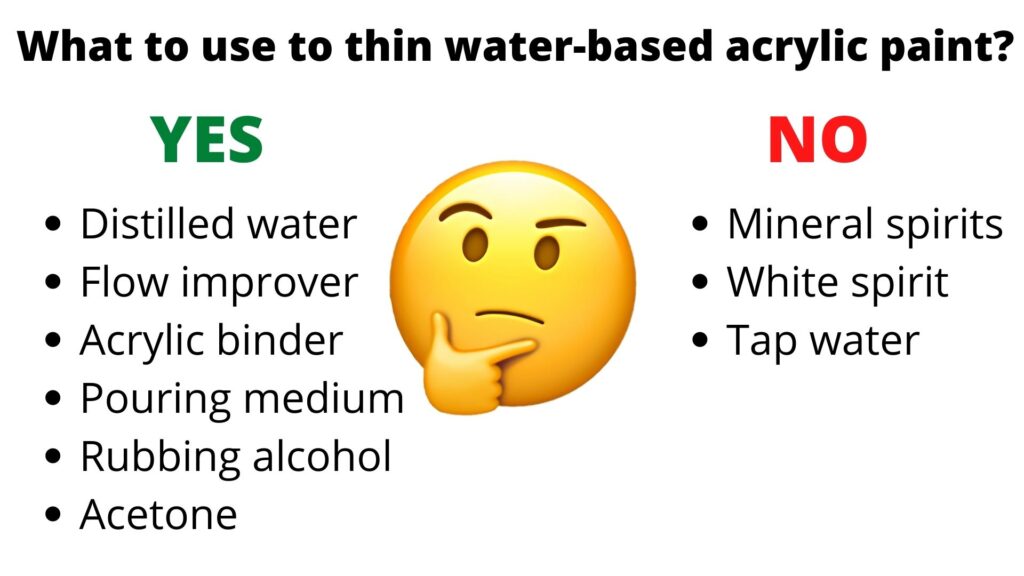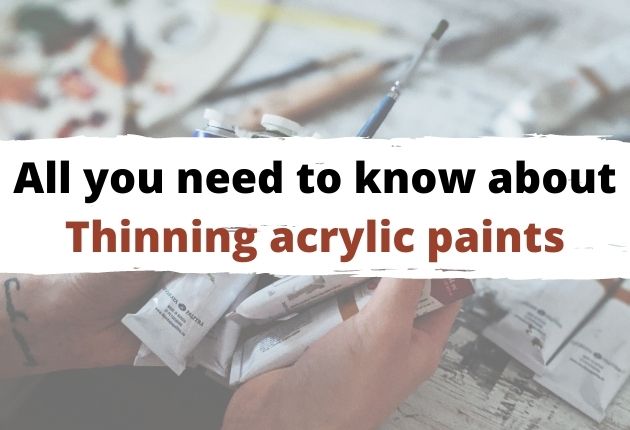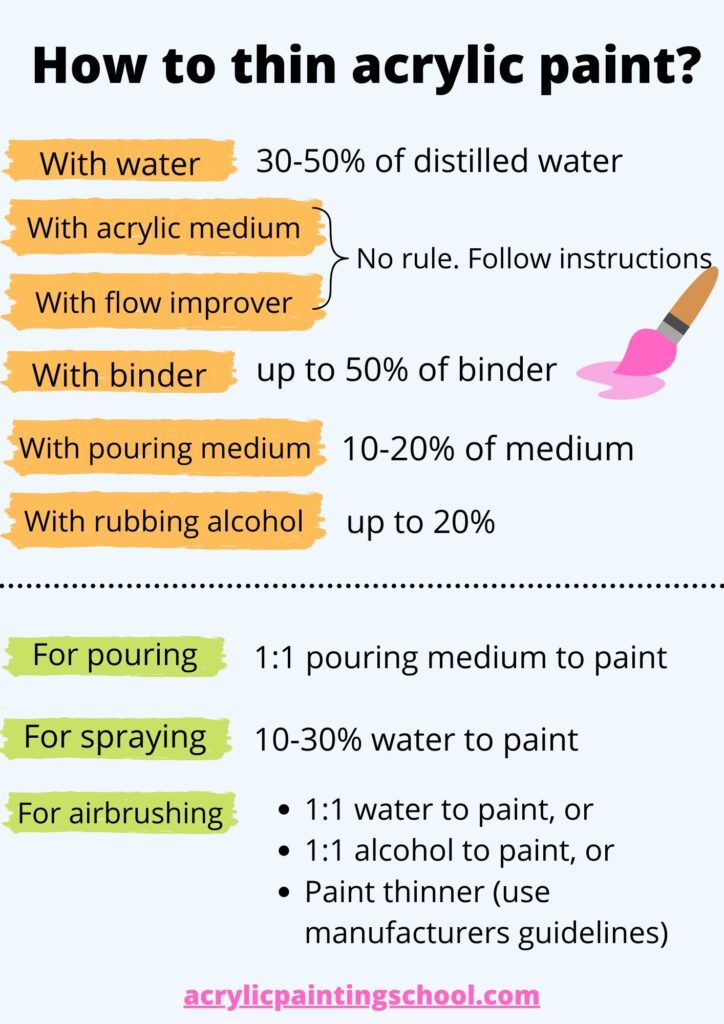Last Updated on April 11, 2024 by Masha Eretnova
Have you heard of thinning acrylic paints yet so far it is not quite a clear concept? You also probably hear opposite opinions as of using or not water vs medium and it only gets more confusing.
To lightly thin acrylic paint, you can add water or wet the brush. To make the paint much thinner, you should use acrylic mediums or binder, or a pouring medium. The most effective way to thin acrylics is to use acrylic medium or GAC100.
- You can thin acrylic paint by adding up to 30 percent water – it will thin the paint just enough to still have a good coverage.
There are also some ingredients that should be never used as thinner such as spirits even though people keep using them.
For the past 3 years, I regularly used water and GAC 100 to thin my acrylic as well as experiment with other mediums to see what works best. And in this post, I’m sharing 14 options you should or should never use.
This article contains affiliate links. It means no extra cost for you but a little commission (2-3%) for me to support my hobby and blog. Thank you!
Table of Contents
Related: How to Fix Lumpy & Chunky Acrylic Paint? [10 Easy Methods]
What does thinning acrylic paints mean?
Thinning acrylic paint – is a process of adding to acrylic paint water or any other medium which will slowly dissolve the paint making it thinner, more fluid, and easier to flow as a result.
The thinning acrylic paint also creates a lighter consistency and viscosity.
do you need paint thinner for acrylic paint?
We can thin acrylic paint when the viscosity seems too thick for us but it is optional.
Thinning acrylic paints help us get different consistencies, colors, and effects (thinned acrylic paint may look like watercolor).
You can use acrylic paint without thinner if it is not too thick for you, but thinner will make it flow better and will save paint.
You don’t need a thinner for fluid acrylic paint.
For a better understanding of why we need to thin acrylic paint and what do you thin acrylic paint with, you should know exactly what is acrylic paint and what are its main characteristics.
Acrylic paint composition:
- pigments give color to paints
- binder has 3 main functions: assuring waterproofness, gloss, and fast and even drying
- other agents provide durability.

One of the main characteristics of acrylic paint is its water-soluble properties.
Acrylic polymer emulsion and pigmenting agent that makes acrylic paint water-soluble and sensitive to thinning.
Remember this term – acrylic polymer emulsion – if you see acrylic polymer emulsion in the thinning medium composition, it means pigments will be bonded and permanently stay on your canvas and your paint will not peel.
Water doesn’t contain any acrylic polymer emulsion.
What to use to thin acrylic paint?
We agree now that before painting we should thin our paint. What to use to thin acrylic paint? There are 2 most popular ways to thin acrylic paint: water and a range of mediums.

The thinner for acrylic paint I use:
- Liquid acrylic polymer emulsion ideal for diluting and extending colors, increasing flexibility, and enhancing film integrity
- Wets out solids more readily than other polymers
- Useful for creating homemade paints
- Made in USA, Employee-Owned Company
In fact, many people, especially artists who worked with oil before, wonder if you can thin acrylic paint with alcohol, spirits, or acetone.
Despite the popularity of thinning acrylic paints with water, some painters say that you should never use water to thin your paint.
I will help you to see all the precautions to each method and help to choose the best method how to make acrylic paint thinner.

Thinning acrylic paints with water – It is that easy
Can you dilute acrylic paint with water? Yes, you can thin acrylic paint with water. Water is the most common and cheapest ingredient for thin acrylic paint.
Water is the easiest way to thin acrylic paint because water affects the composition directly, more specifically – the binder, and slowly dissolves it.
But this method is not highly recommended for beginners because even a slight over-pouring of water can potentially ruin the painting.

The right ratio for thinning with water depends on what effects you need and the surface you paint on.
The best way to thin acrylic paint with water is to mix 30-50% of the water with the paint (1:2 ratio).
- 30% of water or less to acrylic paint thins it lightly and allows you to coat a surface. Add 30% water when your work with pre-primed surfaces.
- 50%+ of water or more creates a watery paint effect called a wash.
Personally, I never use more than 30% of water based on my technique and preferences in abstract painting.
Precautions:
- Use only distilled water.
- Always put a small amount of paint on your palette to make sure you do not waste paint by letting it dry.
- If you experimenting with thinning for the very first time, try to thin your paint with a different amount of water on different palettes. Make notes and remember which ratio was the best for you.
- Use a separate brush to thin acrylic paint with water. Wipe and wash it immediately after thinning.
- Do not add more than 50% of water to avoid peeling. Water breaks binder, the molecules patterns which “glue” the pigment particularly. Water itself doesn’t hold coloring pigment together. Thinning acrylic paint with too much water can result in flaking off and eventually will ruin your painting over time.
- The amount of water does not matter, as any excess is absorbed, and the pigment will remain on the surface when you paint onto an unprimed surface.
- If you are painting fabric do not make your paint too watery, fabric soaks all in and it affects the amount of paint needed, the drying time, and the outcome. The same with painting glass – watery paint won’t stick to the surface.
- For pouring, no matter what pouring techniques you are using, I recommend using special pouring paint or mixing regular paint with pouring mediums like Floetrol or alternatives.
Gentle reminder: use water to thin acrylic paint and then to paint only on primed and well prepared surfaces. Unprepared paper, canvas, fabric or wood will soak the water and harm paint adhesion, quality or longevity of the painting.
Liquitex manufacturers in their official FAQ do not recommend water for thinning acrylic paint.
Read also: Do You Wet The Brush Before Using Acrylic Paint? How To Prepare Your Brush Right
Thinning with acrylic mediums – How Pros Do It
The thinning medium method is the best way to thin acrylic paint for beginners because you don’t have to worry about the ideal ratio and eventual peeling of the paint.
- to thin acrylic paint with medium for opaque coverage, add up to 30% medium
- to thin acrylic paint to create transparent glazes – add up to 60% of medium
This approach is the most effective way to preserve your paintings over time.
There are several mediums that you can use to thin acrylic paint.
Mediums still bond the pigment with the surface, increase UV resistance of the pain and help to achieve different effects, e.i.: watercolor look, glazing; matte, satin, or gloss finish effects; extended dry time; color extension; increased flexibility; additional cracks; shaped surface, etc.
The thinning mediums were designed to thin acrylic paint.
Their only disadvantage is the price – they can be quite expensive. But if it will make your painting last longer or cost more, it is worth it, right?
What mediums I can use to thin acrylic paint:
- Airbrush medium is almost as thin as water and provides smooth application
- Flow improvers are expensive and good for professional artists. They create a stain effect and as the name says improve paint flow.
- Acrylic Binder
- Pouring medium
- Fabric mediums to prepare the paint for painting clothing.
- Golden GAC 100 – acrylic extender. Works both for thinning and extending working time with paint.
Here, in one of the sections below, I sum up the best acrylic thinners for you with prices and notes.

Precautions
- Use only good-quality thinning mediums
- Use your thinner according to the manufacturer’s instructions
Directions
- Put a small amount of paint on your palette. Always work with small amounts of paint because acrylics dry in 20 – 30 minutes.
- Add the medium.
There is no rule about the ratio for thinning mediums.
* If you use pouring medium, add 10-20% of it to paint
* If you use an acrylic binder, add up to 50%
Mix with a palette knife.
3. Check the consistency. Take your palette knife or squeezed brush and apply paint to check if the consistency is right for you.
4. Paint. If you’ve achieved the consistency you were looking for, start painting.
To thin acrylic paint with a binder
As we remember, a binder is a part of the acrylic paint composition. The binder assures waterproofness, gloss, and fast and even drying of the paint.
Using a binder as a thinning medium is a good decision because you will not have to think about the best ratio for mixing or worry about unbound paint.
On the contrary, a binder can add more shine and gloss and will prevent paint from soaking into the surface.
The only precaution you should keep in mind is: do not to add more than 50% of acrylic binder to thin paint.
Acrylic binders you can use:
- Chroma Fusion I.A. Series Pro-Grade Binder Medium, and
- PEBEO Studio Acrylics Auxiliaries, Bindex
Here, in one of the sections below, I sum up the best acrylic thinners for you with prices and notes.
Thinning acrylic paint with pouring medium

The pouring medium was specifically designed for acrylic pouring, but you can use it also for acrylic painting. The pouring medium improves the flow and does not affect pigments or color intensity.
To thin acrylic paint with pouring medium, you add 10% to 20% medium to your paint. Be aware that pouring medium makes the paint dry slower.
Read the guide: How To Thin Acrylic Paint For Pouring: Beginner’s Guide
Thinning acrylic paint with spirits and paint thinners – Should You Risk?
Some artists prefer to use various chemical thinners for thinning acrylic paint. You can also try it with all precautions and strictly following manufacturers’ guidelines.
Spirits as thinning mediums act like solvents. Do not use too many chemical paint thinners in order not to damage the colors.
This is NOT a recommended thinning method for beginners. The best way to thin paint is to use mediums, not spirits.
Can you thin acrylic paint with alcohol?

You can thin water-based acrylic paint with isopropyl (rubbing alcohol). The allowed amount of alcohol you can use to dilute paint is up to 20%.
The use of alcohol will accelerate drying and can result in uneven application.
Thinning acrylics with alcohol can work for airbrushing.
Do not use:
You can NOT thin water-based acrylic paint with white spirit, mineral spirits, vinegar or acetone. Those are absolutely not professional and safe ways to work with acrylic paint.

Reminder: Make sure you start painting on a well prepared surface, e.i. primed canvas, sanded, sealed and primed wood etc.
If you are not sure that you surface is ready and you prefer to avoid peeling and cracking, check my full guides about priming wood, gesso and isolation coat to make sure you're following the right process
14 Best acrylic paint thinners
Gently remind you that the best way is to choose paint thinner of the same brand as your paint. This is why I’ve tried to mention all popular and tested brands in the following table.

| Product | Use | Note | Price |
| Liquitex Flow-Aid Fluid Additive | Flow Improver | 100% acrylic polymer emulsion. Increases the flow, absorbency, and blending of any water-based paint, ink, or dye. Can be used in airbrushes too. Recommended by Liquitex for a watercolor effect. | $6.92 for 4 oz |
| Winsor & Newton Flow Improver | Flow Improver | Premium quality with the best consistency. Preserve the brilliance of the colors. Quick-drying, cracking free. | $11.79 for 4 oz |
| Mont Marte Premium Acrylic Flow Medium | Flow Improver | Highly versatile. Increases the translucency of acrylic paints without affecting their color intensity and vibrancy | $8.99 for 250 ml |
| Golden High Flow Acrylic Paint | Thinner | Maintains the stability and strength of the color and slightly slows drying. Effective for hard-edge painting techniques. Increases the flow of acrylic colors. | $26.52 for 16 oz |
| Reeves Artist Painting Medium | Thinner | It thins acrylic paints and increases flow. It enhances adhesion and durability and increases transparency, intensity, and gloss. | $8.39 for 2,5 oz |
| Createx Colors 4012 High-Performance Reducer | Airbrush reducer | Water-based premium reducer for thinning. You can mix it with paint in any ratio depending on your needs. | $13.79 for 8 oz |
| US Art Supply Airbrush Thinner | Airbrush reducer | Water-based acrylic paint thinning reducer and extender base. Contains acrylic-based binders. | $15.96 for 16 oz |
| Vallejo Airbrush Thinner | Airbrush thinner | Dilutes without loss of color adhesion, durability, or consistency | $13.25 for 200 ml |
| Chroma Fusion I.A. Series Pro-Grade Binder Medium | Acrylic binder | Offers superior adhesion. | $36.68 for 16 oz |
| PEBEO Studio Acrylics Auxiliaries, Bindex | Acrylic binder | Non-yellowing, a liquid binder with a translucent, glossy film. Gives acrylics depth and brightness | $25.59 for 1L |
| Liquitex Professional Pouring Effects Medium | Pouring Medium | Contains acrylic polymer. Creates easy paint flow. Glossy. | $26.49 for 16 oz |
| Golden Artist Colors Color Pouring Medium | Pouring Medium | Low crazing extender for pouring acrylic colors. Glossy. | $19.64 for 16 oz |
| DECOART Pouring Medium | Pouring Medium | Premium quality with the best consistency. Preserves the brilliance of the colors. Quick-drying, cracking free. | $61.99 for 16 oz |
| Floetrol | Pouring Medium | To use only for pouring. It is a latex paint conditioner. It thins and strengths the qualities of latex paint, and improves the coverage. | $27.96 for 1 gal |
Related post: Floetrol for acrylic pouring: Full Guide [Floetrol Recipe & 9 Substitutes]
3 Extra Tips on how to paint with thinning paint
Sometimes, even if we had images in our heads or on sketches, the real painting, colors, and shades don’t look as we wanted.
If the results do not meet your preferences, try this:
- Use a primed surface. The best way to prime your surface is to use gesso. Gesso will provide perfect paint adhesion and color vivacity. To learn more about when gesso is necessary and discover the 11 best gesso, you can read my article about gesso.
- Use the right brush for thinning. The wide brush can be better if you cover a big surface.
- Use the fat over lean method. This method suggests painting in layers: every new layer should be thicker than the previous one. The fat-over-lean method is the basic principle of the painting and protects your work from cracking and peeling.
Read also: How to Use Acrylic Paint: 3 Easy Steps To Paint With Acrylics On Canvas
Related questions
Does thinning paint change the color?
The thinning does not change the color. But if you thin paint with water, remember that water dilutes the paint and lightens its color. In this case, apply additional coats of paint.
How To Thin Acrylic Paint For Models?
For model painting you should use thinned acrylic paint. If you are using an airbrush, dilute you acrylic paint with airbrush thinner. Vallejo,Tamiya and AK Interactive have great thinners for models and miniatures. You got to ratio acrylic paint to thinner will be 3:1 or 4:1.
To achieve the best results in acrylic painting check related posts:
- 11 Ways on How to Blend Acrylic Paint Smoothly
- 11 Easy Methods on How to Sketch on Canvas Before Acrylic Painting

Masha Eretnova, born in 1991, is a Buenos Aires-based certified teacher, artist, and member of the Professional Artist Association with 20+ years of personal painting journey.
She started painting and drawing very early and is now an international abstract artist and educator passionate about acrylic painting, gouache, and crafts.
Her works are part of international exhibitions and contests, including ArtlyMix (Brazil), Al-Tiba 9 (Spain), Exhibizone (Canada), Italy, and many more.
Besides her artistic pursuits, Masha holds a post-grad diploma in Teaching Film Photography and 2 music school diplomas: piano and opera singing.
Last update on 2024-07-26 / Affiliate links / Images from Amazon Product Advertising API

